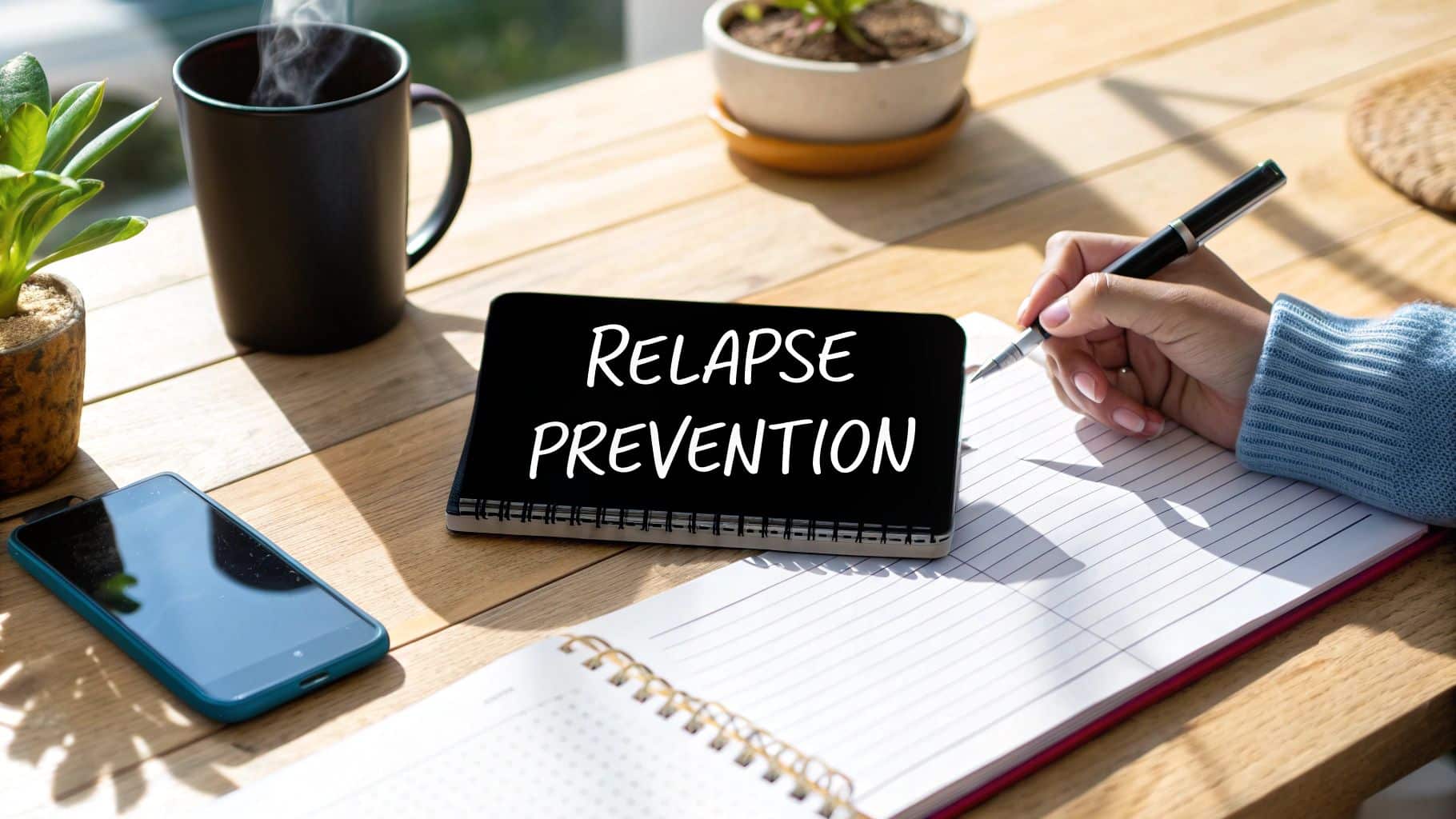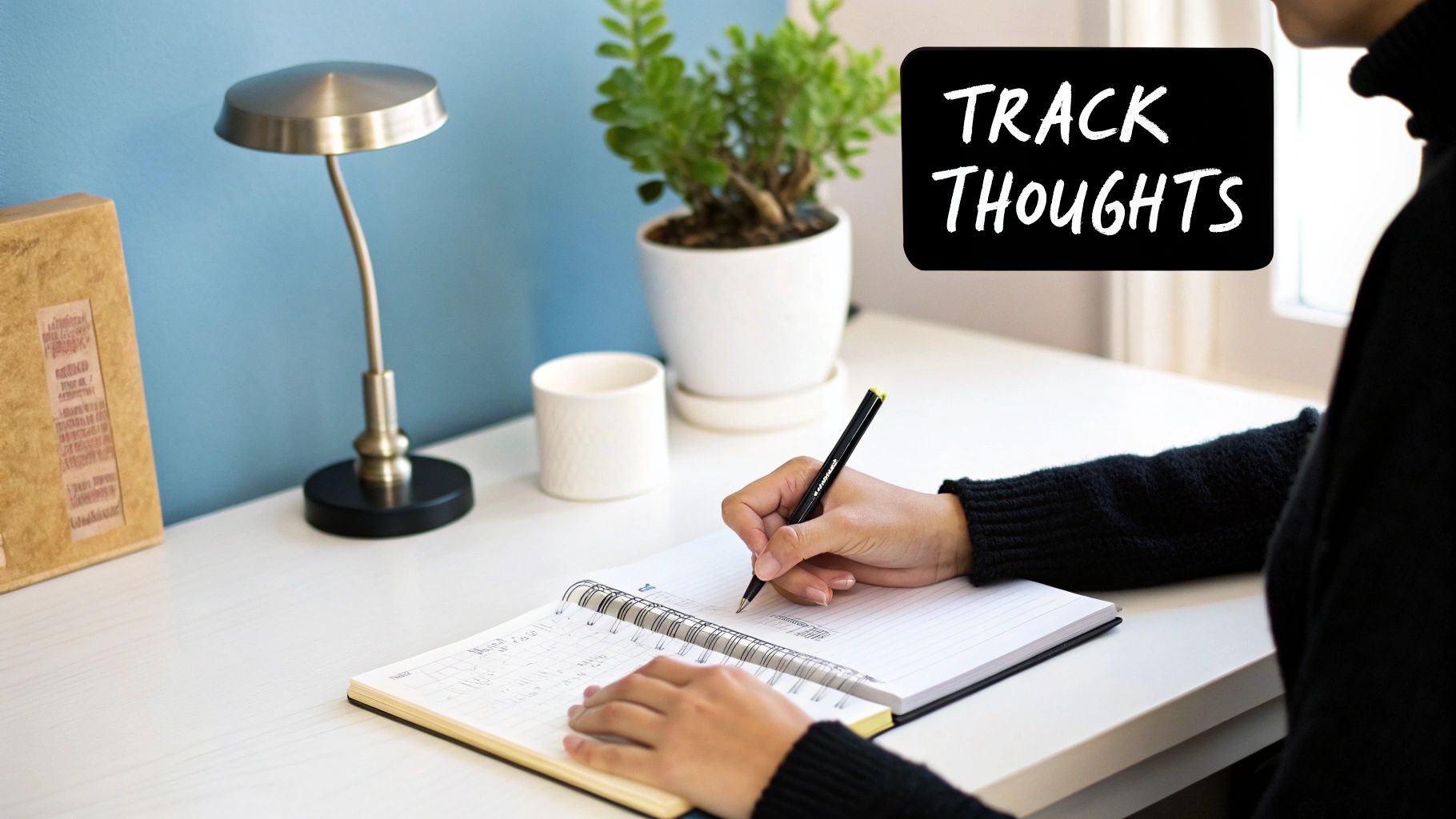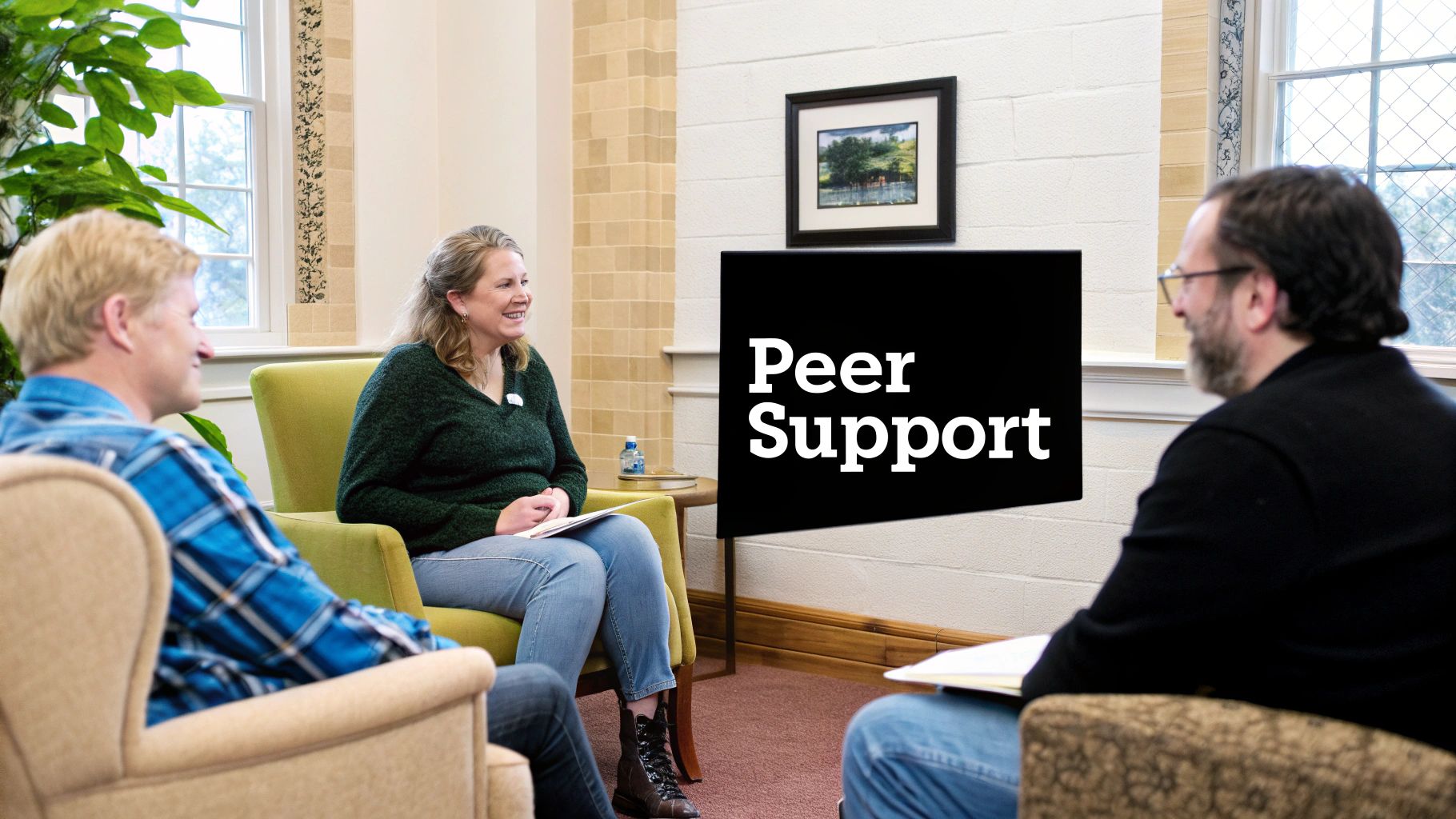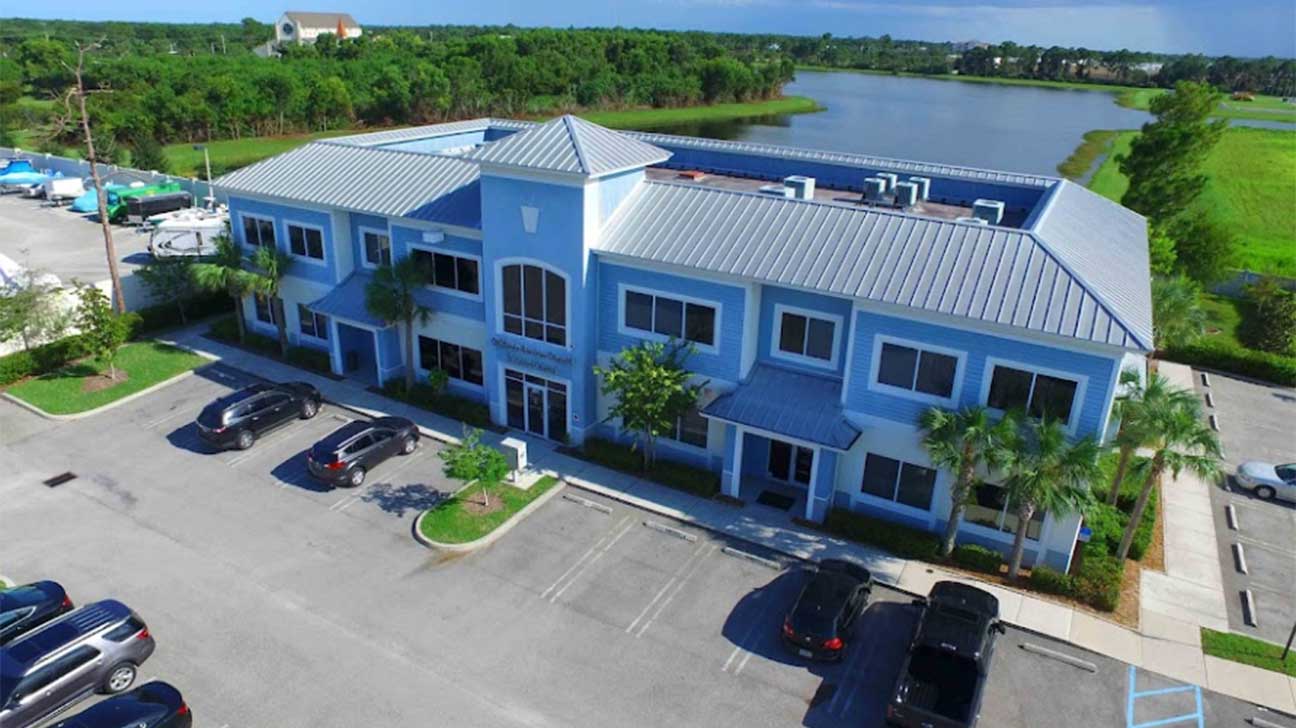
Building a Resilient Foundation for Lasting Recovery
Embarking on the recovery journey is a monumental achievement, but maintaining sobriety requires a robust and proactive plan. Relapse is not a sign of failure, but a part of the complex process that can be managed and often avoided with the right tools. Understanding and implementing effective relapse prevention strategies is crucial for building a resilient, long-term foundation for a healthier, substance-free life. This guide moves beyond generic advice, offering a detailed roundup of eight evidence-based strategies, each providing a unique and powerful approach to navigating the path of recovery.
From cognitive techniques that rewire your thinking to wellness plans that rebuild your life from the ground up, these methods offer actionable steps for individuals and their support networks. We will explore specific, practical frameworks including:
- Cognitive Behavioral Therapy (CBT)
- Mindfulness-Based Relapse Prevention (MBRP)
- SMART Recovery principles
- Contingency Management interventions
- Medication-Assisted Treatment (MAT)
- Building robust social support networks
- Strategic lifestyle and wellness planning
- The role of Trauma-Informed Care
Whether you are just starting your journey or looking to strengthen your existing plan, these insights will equip you with the practical skills needed to anticipate challenges, manage triggers, and cultivate a fulfilling life in recovery. This article provides the actionable details you need to turn these concepts into a concrete part of your daily life. If you or a loved one needs immediate support, remember that resources like the SAMHSA National Helpline at 1-800-662-4357 are available 24/7 to provide confidential guidance and connect you with the help you need.
1. Cognitive Behavioral Therapy (CBT) for Relapse Prevention
Cognitive Behavioral Therapy (CBT) is a cornerstone among effective relapse prevention strategies, focusing on the powerful connection between thoughts, feelings, and actions. Pioneered by figures like Aaron Beck, this therapeutic approach equips individuals with the tools to deconstruct and reframe the automatic negative thought patterns that often fuel addictive behaviors. The core principle is that by changing distorted thinking, you can change your behavioral responses, especially in high-risk situations.

This therapy is highly structured and goal-oriented. A therapist helps you identify specific triggers, whether they are people, places, or internal emotional states like stress or boredom. You then learn to anticipate these triggers and develop practical coping mechanisms to navigate them without resorting to substance use. Its effectiveness is so well-documented that it forms the basis of many successful programs, such as the Matrix Model for methamphetamine treatment and various CBT-based initiatives within Veterans Affairs medical centers. For a deeper look into this and other therapeutic modalities, you can explore the different types of addiction therapy available.
How to Implement CBT Techniques
Integrating CBT into your daily life is key to its success. Here are actionable steps to apply these principles:
- Keep a Thought Record: This is a simple journal where you log a situation, the automatic thought that came with it, the resulting feeling, and your behavior. This practice brings unconscious thought patterns to light, making them easier to challenge and change.
- Challenge Your Beliefs: Use “behavioral experiments” to test the validity of your negative beliefs. For example, if you believe you can’t socialize without drinking, challenge yourself to attend a low-risk social event and stay sober for a set period. Document the outcome to provide concrete evidence against your old belief.
- Develop New Coping Skills: Instead of turning to substances, build a toolkit of healthy responses to stress. This could include deep breathing exercises, mindfulness meditation, going for a walk, or calling a trusted member of your support system.
- Practice Self-Monitoring: Regularly check in with yourself to recognize early warning signs of a potential relapse. These can include romanticizing past use, isolating yourself, or neglecting self-care routines. Catching these signs early allows you to deploy your CBT skills before a craving escalates.
2. Mindfulness-Based Relapse Prevention (MBRP)
Mindfulness-Based Relapse Prevention (MBRP) is a powerful, evidence-based approach that combines the principles of mindfulness meditation with the practical tools of cognitive-behavioral therapy. Developed by researchers like Sarah Bowen and Alan Marlatt at the University of Washington, this strategy teaches individuals to cultivate a non-judgmental, present-moment awareness of their thoughts, feelings, and bodily sensations. The core idea is not to eliminate cravings but to change your relationship with them, learning to observe them as temporary events rather than overwhelming commands that demand action.

This approach empowers you to pause and create space between an impulse and a reaction, which is a critical skill for managing high-risk situations. Instead of being on autopilot, you learn to respond with intention. MBRP has been successfully implemented in various settings, from outpatient addiction clinics to innovative prison-based treatment programs, demonstrating its versatility. For those interested in its core concepts, the work coming from the University of Washington’s Addictive Behaviors Research Center provides extensive resources and research on the topic.
How to Implement MBRP Techniques
Applying MBRP involves integrating mindfulness into your daily routine to build resilience against relapse triggers. Here are some actionable ways to practice MBRP:
- Practice “Urge Surfing”: When a craving arises, instead of fighting it or giving in, treat it like a wave. Acknowledge its presence, notice the physical and mental sensations it brings, and observe it as it builds, peaks, and eventually subsides. This teaches you that cravings are transient.
- Start with Short, Guided Meditations: Begin with just 5-10 minutes of daily guided meditation. Apps like Calm or Headspace, or even free YouTube videos, can provide structure. This practice trains your brain to focus and stay in the present moment.
- Engage in Mindful Activities: You don’t have to be sitting on a cushion to practice mindfulness. Apply the principles to everyday activities. When eating, pay full attention to the taste, texture, and smell of your food. When walking, notice the sensation of your feet on the ground.
- Join a Group: Practicing MBRP with others can provide crucial support and accountability. Many treatment centers and community organizations offer MBRP groups where you can share experiences and learn from others who are using these same relapse prevention strategies.
3. SMART Recovery (Self-Management and Recovery Training)
SMART Recovery offers a distinct, science-based approach among relapse prevention strategies, centered on self-empowerment and personal choice. Founded by professionals like Joe Gerstein, this program uses cognitive-behavioral and motivational techniques to give individuals direct control over their recovery. Instead of a step-based model, SMART Recovery is built on a 4-Point Program designed to help people gain independence from any addictive behavior, from substance use to activities like gambling or overeating.
This infographic summarizes the core principles of the SMART Recovery model, which emphasizes a structured yet flexible path to self-management.

The program’s focus on self-empowerment, supported by its practical four-point structure and accessible meeting formats, makes it a powerful tool for building lasting change. Its effectiveness and adaptability have led to its integration into diverse settings, including employee assistance programs, the UK’s National Health Service, and numerous VA medical centers across the United States. You can find more information and resources directly on the official SMART Recovery website.
How to Implement SMART Recovery Principles
Actively applying SMART tools is crucial for managing urges and maintaining a balanced life. Here are actionable methods to integrate these principles:
- Practice the ABCs of REBT: This foundational tool helps you break down irrational beliefs. Identify an Activating event (a trigger), pinpoint your Beliefs about it, and analyze the emotional and behavioral Consequences. By disputing the irrational belief, you can change the consequence.
- Utilize a Change Plan Worksheet: This worksheet helps you formalize your recovery goals. You outline your objectives, the steps needed to achieve them, potential obstacles, and how you will overcome them. Regularly reviewing and updating this plan keeps your focus sharp.
- Use the DISARM Tool for Urges: When a craving hits, Destructive Images and Self-talk Are Replacing More constructive ones. The goal is to recognize this destructive self-talk and actively replace it with rational, motivating thoughts that reinforce your commitment to recovery.
- Set SMART Goals: Apply the Specific, Measurable, Achievable, Relevant, and Time-bound framework to your recovery objectives. For example, instead of “I want to be healthier,” a SMART goal would be, “I will attend three online SMART meetings per week and exercise for 30 minutes on Monday, Wednesday, and Friday for the next month.”
Call Now – Your Journey to Recovery Begins Today!

Take the first step towards a healthier life! Call now to connect with our compassionate team and start your recovery journey today. Your path to healing awaits!
Our recovery specialists are available 24/7 to provide support, and all calls are confidential and free. Reach out anytime – we’re here to help!
4. Contingency Management
Contingency Management (CM) is one of the most effective behavioral relapse prevention strategies, operating on the straightforward principle of positive reinforcement. This approach provides tangible, immediate rewards for verified evidence of positive behaviors, such as maintaining abstinence. Grounded in the principles of operant conditioning, CM strengthens recovery-focused actions by making them more rewarding than the act of using substances. The core idea is that consistent, desirable consequences will increase the likelihood of repeating a desired behavior.
Pioneered by researchers like Stephen Higgins and Nancy Petry, this method has proven highly effective across various substance use disorders. Unlike talk therapy, which focuses on internal states, CM directly targets and modifies external behavior through a structured reward system. Its success is well-documented in numerous settings, from community clinics using prize-based draws to more formal programs like the “fishbowl method” utilized in Veterans Affairs medical centers, where patients draw for prizes of varying value for each negative drug test. This direct, incentive-based approach makes it a powerful component of a comprehensive recovery plan.
How to Implement Contingency Management Principles
Integrating a CM framework, whether in a formal treatment setting or with a supportive loved one, requires structure and consistency. Here are actionable steps to apply its principles:
- Establish Clear Behavioral Targets: Define specific, measurable, and achievable goals. The most common target is a negative urine or breathalyzer test, but it can also include attending therapy sessions, engaging in job-seeking activities, or taking prescribed medication consistently.
- Choose Meaningful Rewards: The incentives must be genuinely motivating to the individual. They don’t have to be expensive; they can range from small retail gift cards and movie tickets to larger prizes for sustained abstinence. The key is that the reward is desirable enough to compete with the reinforcing effects of substance use.
- Ensure Immediacy and Consistency: Reinforcement should be delivered as soon as possible after the target behavior is verified. This immediate connection between the positive action and the reward is crucial for strengthening the new behavior pattern.
- Gradually Fade the Rewards: As the individual builds intrinsic motivation and healthier habits become more established, the frequency and value of the rewards can be slowly reduced. This process, known as “thinning the reinforcement schedule,” helps transition the person from relying on external incentives to finding internal satisfaction in their sobriety.
5. Medication-Assisted Treatment (MAT)
Medication-Assisted Treatment (MAT) stands as a highly effective, evidence-based relapse prevention strategy, particularly for opioid and alcohol use disorders. It integrates FDA-approved medications with counseling and behavioral therapies to provide a comprehensive, “whole-patient” approach to recovery. The core principle of MAT is to correct the neurobiological imbalances caused by addiction, thereby reducing physiological cravings and withdrawal symptoms. This stabilization allows individuals to engage more fully in the psychological and behavioral work necessary for long-term sobriety.
This approach is not about substituting one drug for another; it’s a medical treatment designed to normalize brain chemistry and block the euphoric effects of substances. Leading organizations like the Substance Abuse and Mental Health Services Administration (SAMHSA) and the National Institute on Drug Abuse champion MAT for its proven ability to decrease illicit drug use and improve survival rates. Its implementation is seen in various settings, from specialized methadone clinics for opioid treatment to primary care offices where doctors can prescribe buprenorphine, making treatment more accessible. You can learn more about its role from addiction medicine specialists and resources provided by the American Society of Addiction Medicine.
How to Implement Medication-Assisted Treatment
Successfully engaging with MAT requires a collaborative effort between you, your healthcare provider, and your support system. Here are actionable steps for integration:
- Work with Qualified Providers: Seek out physicians, nurse practitioners, or physician assistants who are experienced and certified in addiction medicine. They can conduct a thorough assessment to determine if MAT is right for you and which medication is most appropriate for your specific needs.
- Combine Medication with Counseling: Medication is just one part of the equation. For the best outcomes, it is crucial to actively participate in counseling or behavioral therapy. This helps you address the root causes of addiction, develop coping skills, and build a foundation for life in recovery.
- Be Patient with Dosing: Finding the right medication and dosage can take time. It often requires a period of adjustment and open communication with your provider about how you are feeling, any side effects, and the level of your cravings. Patience is key to finding the therapeutic dose that works for you.
- Maintain Medical Monitoring: Regular appointments with your healthcare provider are essential. These check-ins are used to monitor your progress, manage side effects, and make any necessary adjustments to your treatment plan, ensuring your safety and the medication’s effectiveness as one of your primary relapse prevention strategies.
6. Social Support Networks and Peer Recovery
One of the most powerful relapse prevention strategies involves cultivating a strong network of social and peer support. This approach is built on the fundamental human need for connection and shared experience, recognizing that isolation is a significant risk factor for relapse. By engaging with others who understand the recovery journey, individuals gain a sense of belonging, accountability, and invaluable encouragement. The principle is simple yet profound: recovery is not a solitary journey, and strength is found in community.

This strategy was popularized by the founders of Alcoholics Anonymous, Bill Wilson and Dr. Bob Smith, and has since expanded into countless formats. Modern examples include Narcotics Anonymous (NA), SMART Recovery groups, and the rise of certified peer recovery coaches integrated into healthcare systems. These networks provide a safe space to share struggles and triumphs without judgment. The value of these communities is central to long-term success, forming a key component of robust aftercare and relapse prevention plans.
How to Implement Social and Peer Support
Actively building and participating in a support network is crucial for its effectiveness. Here are actionable steps to integrate this strategy into your recovery:
- Explore Different Groups: Don’t feel discouraged if the first group you try isn’t the right fit. Attend various meetings, whether they are 12-step based like AA/NA or secular alternatives like SMART Recovery, to find a community where you feel comfortable and understood.
- Establish Key Contacts: Identify a few trusted individuals within your network whom you can call during moments of high stress or craving. Having multiple contacts ensures someone is likely to be available when you need support the most.
- Participate Actively: Move beyond passive attendance. Share your experiences in meetings, volunteer for service positions, and engage with others before and after the gathering. Active participation builds stronger bonds and a deeper sense of accountability.
- Develop Sober Social Activities: A strong network extends beyond formal meetings. Organize or join sober activities like hiking, game nights, or coffee meetups. This helps prove that a fun, fulfilling social life is possible without substance use and reinforces healthy friendships.
- Consider Peer Mentorship: As you become more stable in your recovery, think about becoming a sponsor or peer mentor for someone newer to the journey. This not only helps another person but also reinforces your own commitment to sobriety.
Call Now – Your Journey to Recovery Begins Today!

Take the first step towards a healthier life! Call now to connect with our compassionate team and start your recovery journey today. Your path to healing awaits!
Our recovery specialists are available 24/7 to provide support, and all calls are confidential and free. Reach out anytime – we’re here to help!
7. Lifestyle Modification and Wellness Planning
Lifestyle Modification and Wellness Planning is a comprehensive relapse prevention strategy that moves beyond simply avoiding substances to building a life where they are no longer needed. This approach recognizes that addiction often fills a void related to physical health, emotional well-being, or a lack of purpose. Championed by figures like Mary Ellen Copeland, who developed the Wellness Recovery Action Plan (WRAP), and recovery researcher William White, this strategy focuses on creating a new, fulfilling life structure that actively supports long-term sobriety.
The core principle is to systematically replace unhealthy habits associated with substance use with positive, health-promoting routines. This involves a holistic overhaul of daily life, addressing everything from nutrition and exercise to stress management and spiritual connection. By proactively building a balanced and meaningful existence, you reduce the underlying vulnerabilities that can trigger a relapse. This method is a cornerstone of recovery-oriented systems of care and is often integrated into therapeutic communities and workplace wellness programs for employees in recovery. To explore similar integrated approaches, you can learn more about the benefits of holistic drug rehab programs.
How to Implement Lifestyle and Wellness Planning
Integrating this strategy requires conscious, daily effort to build new patterns. Here are actionable steps to create a recovery-supportive lifestyle:
- Create a Structured Daily Routine: A consistent schedule provides stability and reduces the unstructured time where cravings or negative thoughts can take hold. Plan your day from morning to night, including wake-up times, meals, work or school commitments, exercise, and a wind-down routine before bed.
- Start with Small, Manageable Changes: Trying to change everything at once can be overwhelming. Begin with one or two small goals, such as adding a 15-minute walk to your day or swapping one unhealthy snack for a piece of fruit. Success with small changes builds momentum for bigger ones.
- Prioritize Physical Health: Incorporate physical activity you genuinely enjoy, whether it’s hiking, dancing, team sports, or yoga. Pair this with a focus on nutrition by planning balanced meals that stabilize your mood and energy levels, reducing the physical stress that can lead to cravings.
- Identify and Pursue Meaningful Activities: Recovery is not just about what you stop doing; it’s about what you start doing. Rediscover old hobbies or explore new interests that provide a sense of purpose and joy. This could be volunteering, taking a class, joining a club, or working on a creative project that fills the space once occupied by addiction.
8. Trauma-Informed Care and Therapy
Trauma-Informed Care is a critical framework among relapse prevention strategies that acknowledges the profound connection between traumatic experiences and substance use. This approach, heavily influenced by pioneers like Bessel van der Kolk and Judith Herman, shifts the focus from asking “What’s wrong with you?” to “What happened to you?” It recognizes that many individuals turn to substances as a way to self-medicate the overwhelming emotional and physiological symptoms of trauma. The core principle is that to achieve lasting sobriety, the underlying trauma must be addressed safely and effectively.
This model is not a single therapy but an overarching philosophy that integrates knowledge about trauma into every aspect of care. It prioritizes creating a safe, stable, and empowering environment where individuals can heal without being re-traumatized. Specialized therapies are then employed to process traumatic memories and build resilience. This approach is central to effective programs like Seeking Safety, developed by Lisa Najavits, which directly addresses co-occurring trauma and addiction, and is widely promoted by SAMHSA’s national initiatives.
How to Implement Trauma-Informed Approaches
Integrating a trauma-informed perspective into your recovery journey involves both professional guidance and personal practice. Here are actionable steps to apply these principles:
- Seek Specialized Professional Help: Look for therapists or programs explicitly trained in both trauma and addiction. Modalities like Eye Movement Desensitization and Reprocessing (EMDR) and Trauma-Focused Cognitive Behavioral Therapy (TF-CBT) are designed to process traumatic memories without causing overwhelming distress.
- Practice Grounding Techniques: Trauma can leave you feeling disconnected from your body and the present moment. Practice grounding exercises to anchor yourself. Focus on your five senses: name five things you can see, four things you can touch, three things you can hear, two things you can smell, and one thing you can taste.
- Go at Your Own Pace: Healing from trauma is not a linear process and there is no set timeline. It is crucial to be patient with yourself and honor your own pace. Pushing too hard or too fast can be counterproductive and destabilizing, making it one of the most important relapse prevention strategies to respect your limits.
- Build a Safe Support System: Cultivate relationships with people who are understanding, non-judgmental, and respectful of your boundaries. This could include a therapist, a sponsor, trusted friends, or a support group specifically for individuals with a history of trauma.
Relapse Prevention Strategies Comparison Table
| Approach | Implementation Complexity 🔄 | Resource Requirements ⚡ | Expected Outcomes 📊 | Ideal Use Cases 💡 | Key Advantages ⭐ |
|---|---|---|---|---|---|
| Cognitive Behavioral Therapy (CBT) | Moderate – structured sessions with homework | Moderate – trained therapist required | Reduces relapse by modifying thoughts and behaviors | Individuals motivated for active engagement | Evidence-based, practical skills, short-term |
| Mindfulness-Based Relapse Prevention (MBRP) | Moderate – requires regular mindfulness practice | Low to moderate – guided practice tools | Reduces craving/reactivity, improves emotional regulation | Those seeking present-moment awareness and stress reduction | Improves emotional regulation, supports independent practice |
| SMART Recovery | Low to moderate – self-management focus | Low – online/peer meetings available | Enhances motivation, coping, and balanced living | Individuals preferring science-based, flexible recovery | Empowering, flexible, strong toolkit and community |
| Contingency Management | Moderate – systematic reward system setup | High – rewards and monitoring resources | Higher abstinence rates, improved retention | Especially effective for stimulant use disorders | Immediate motivation, strong evidence base |
| Medication-Assisted Treatment (MAT) | High – medical oversight and medication management | High – medical providers, medications | Reduces overdose risk, cravings, improves retention | Opioid and alcohol use disorders requiring medical support | Life-saving, medically supervised, comprehensive |
| Social Support Networks and Peer Recovery | Low – group or peer-led support | Low – peer volunteers and meeting spaces | Sustained recovery via ongoing support and accountability | Those benefiting from community and peer connection | Low cost, reduces isolation, provides hope and belonging |
| Lifestyle Modification and Wellness Planning | Moderate – ongoing lifestyle changes | Low to moderate – wellness resources | Improved quality of life, natural mood/stress relief | Individuals seeking holistic, long-term recovery support | Holistic, builds self-efficacy, addresses root causes |
| Trauma-Informed Care and Therapy | High – specialized trauma training needed | High – trained therapists, longer duration | Addresses trauma, reduces PTSD symptoms, improves complex cases | Individuals with trauma histories underlying addiction | Root cause focus, comprehensive healing, empowerment |
Integrating Your Strategies for a Personalized Path Forward
The journey through recovery is not a rigid, linear path. It is a dynamic process of growth, self-discovery, and adaptation. The eight distinct relapse prevention strategies we’ve explored, from Cognitive Behavioral Therapy to Lifestyle Modification, are not meant to be a checklist you simply complete. Instead, view them as a versatile toolkit, a collection of powerful instruments you can select, combine, and master to build a recovery plan that is uniquely and authentically yours.
The true strength of these approaches emerges not in isolation, but in their integration. Your most resilient defense against relapse is a multi-layered one, thoughtfully constructed to address your specific triggers, history, and personal goals. The most effective relapse prevention strategies are those that work in harmony, creating a comprehensive support system that nurtures your long-term well-being.
Weaving Your Personal Safety Net
Think of building your plan like an architect designing a resilient structure. You need a solid foundation, flexible materials, and systems that work together. Here’s how you can begin to weave these individual strategies into a cohesive and personalized plan:
Foundation of Self-Awareness: Start with the principles of CBT and MBRP. Use Cognitive Behavioral Therapy to identify the specific thought patterns and situations that have historically led to substance use. Concurrently, practice Mindfulness-Based Relapse Prevention to develop the crucial skill of observing these thoughts and cravings without immediately reacting to them. This combination creates a powerful foundation of awareness and conscious choice.
Structure of Empowerment: Build upon that foundation with the proactive tools of SMART Recovery. Its emphasis on self-management, motivation, and goal-setting provides the framework for your daily recovery efforts. You can use SMART Recovery techniques to set achievable wellness goals, like integrating the Lifestyle Modification practices we discussed, such as consistent exercise or improved nutrition.
Reinforcement and Support: No structure stands alone. Your Social Support Network and Medication-Assisted Treatment (MAT), if applicable, are critical reinforcements. Your peers, family, and sponsors provide accountability and encouragement, while MAT can offer the biological stability needed to fully engage in therapeutic work. This external support system is vital, especially when facing unexpected challenges or intense cravings.
Healing the Core: For many, substance use is intertwined with past pain. Integrating Trauma-Informed Care is not just an optional add-on; it is essential for healing the underlying wounds that may drive the desire to self-medicate. Addressing trauma within a safe therapeutic relationship allows you to resolve root causes rather than just managing symptoms, making your entire recovery structure more secure and sustainable.
Call Now – Your Journey to Recovery Begins Today!

Take the first step towards a healthier life! Call now to connect with our compassionate team and start your recovery journey today. Your path to healing awaits!
Our recovery specialists are available 24/7 to provide support, and all calls are confidential and free. Reach out anytime – we’re here to help!
Your Proactive Path Forward
Your recovery is a living, breathing part of your life, and your relapse prevention plan should be too. It requires active participation, not passive observance. The most important takeaway is this: your plan must evolve as you do. What works for you in the first few months of recovery might need adjustment a year or two down the road as you encounter new life stressors, achieve different milestones, or develop new coping skills.
Commit to a regular “recovery check-up” with yourself, your therapist, or your sponsor. Ask critical questions:
- Which strategies are feeling most effective right now?
- Are there any new triggers or high-risk situations I need to plan for?
- Is any part of my plan feeling stale, neglected, or ineffective?
- How can I deepen my practice of a particular strategy, like mindfulness or wellness planning?
Mastering these relapse prevention strategies is more than just avoiding a return to substance use; it is about building a life that is so fulfilling, meaningful, and resilient that the old ways of coping no longer hold the same appeal. It is a commitment to your health, your relationships, and your future.
If you are feeling unsure of how to begin integrating these complex strategies or need help creating a truly personalized plan, remember that reaching out for expert guidance is a sign of profound strength. The right support can make all the difference in navigating this crucial process.
Navigating the complexities of recovery and building an effective plan can be overwhelming, but you don’t have to do it alone. Addiction Helpline America provides a confidential and immediate connection to experienced professionals who can help you assess your needs and build the personalized relapse prevention strategies that will work for you. Contact Addiction Helpline America to take the definitive next step on your path to lasting wellness.
Our helpline is 100%
free & confidential
If you or someone you care about is struggling with drug or alcohol addiction, we can help you explore your recovery options. Don’t face this challenge alone—seek support from us.
Programs
Resources
Will my insurance
cover addiction
treatment?
We're ready to help
Find the best
drug or alcohol treatment
center
Are you or a loved one struggling with addiction? Call today to speak to a treatment expert.















